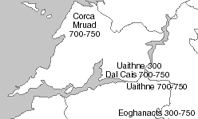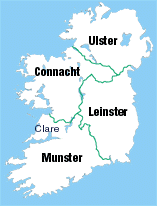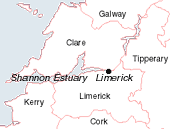Ancient
Origins
of the Greene clan in Irish
History
Early origins of the
Greenes
Although the name Green derives from the Gaelic
Uaithne
(for green), there is no evidence of a direct connection
between
the ancient Uaithne tribe (referred to below) and the
O hUaithnin. families of Clare.
The
proximity of the areas occupied by the Uaithne tribe
and the O
hUaithnin families, however, appears to be close
enough to suggest some
connection.
The Greenes, are, as explained below, a Dalcassian
family,
descended from the Dal Cais, best known of whom is Brian Boru.
The
following sets out the early history of the Uaithne and
the
Dalcassians.
 According to the
website "Ireland
History in Maps"
(www.fortunecity.com/bally/kilkenny/2/iremaps.htm),
a map drawn up by
Ptolemy in 150 AD shows the Auteini on the west
coast of Ireland. This
tribe is 'later identified as the Uaithne
of County Limerick and
Tipperary'.
According to the
website "Ireland
History in Maps"
(www.fortunecity.com/bally/kilkenny/2/iremaps.htm),
a map drawn up by
Ptolemy in 150 AD shows the Auteini on the west
coast of Ireland. This
tribe is 'later identified as the Uaithne
of County Limerick and
Tipperary'.
The word Uaithne appears first (on the
aforementioned website)
on a map of Ireland (with the subtitle 'Royal
provinces and sites
- circa 300AD), in Clare, just north of Limerick.
The word Uaithne appears again on another map subtitled
'Lesser
kingdoms and other Dynasties, 700AD', with the Dal Cais (north
of
Limerick) as a kingdom and Uaithne (just south of Limerick,
in County
Limerick) as a dynasty.
Similarly, both the Dal Cais and Uaithne appear
in similar positions
on a map of Munster (the south west corner of Ireland,
including
Clare) in 750AD.
 The text of the
website also states,
of Thomond (region similar to present day
Clare):
The text of the
website also states,
of Thomond (region similar to present day
Clare):
"Early people of Thomond included the Corca Baiscind,
Uaithne,
Corca Mruad and the Dal gCais"
The text also mentions
Aillil Olumm (Oilill Olum), a king of Munster
(fourth century?), who had
three sons, the eldest Cas (whose son
was Cormac Cas - their descendants
Dalcassians) and Eoghan Mor
(descendants the Eoghanacts).
The
Dalcassians
According to Dr. Edward McLysaght in his Book
"Irish
Families Their Names and Origins" (published in the
late
1950s), the name Greene in County Clare is one of several
genuinely
Dalcassian families.
Peter Mulquiney, in his history of the
Mulqueeney family, (my
great grandmother was a Mulqiney) established that
the Mulqueeneys
too were Dalcassians. Another Dalcassian family is the
Sheehans
(a Sheehan married my mother's cousin in Wentworth,
NSW).
 Descendants of Cas were
called
the Dal gCais, or Dalcassians (eg. O Brien, MacDonnell, O Grady,
O
Healy, O Kennedy, Macnamara, Quinn, Aherne and Malone). The
Norse had
pushed the Dalcassians back into a small area of East
Clare, controlling
the Shannon river estuary.
Descendants of Cas were
called
the Dal gCais, or Dalcassians (eg. O Brien, MacDonnell, O Grady,
O
Healy, O Kennedy, Macnamara, Quinn, Aherne and Malone). The
Norse had
pushed the Dalcassians back into a small area of East
Clare, controlling
the Shannon river estuary.
Descendants of Eoghan Mor were the
Eoghanacts (eg. O Callaghans,
McCarthys, O Donohue, McGillicuddy, O Keefe,
O Moriarty and O
Sullivans). The Eoghanacts were active from the 5th to
11th centuries,
gaining power in most of the south of Ireland around 700.
They
ruled from Cashel, but after the Norse invasions, their province
was
dominated by Norsemen.
The Vikings (the Norse) sacked the early
settlement of Limerick
in 812 and made it the principal town of their
kingdom.
County Limerick was the ancient home of Uí Fidgeinte,
Uaithne,
Corca Oiche, Orbraige, Uí Cairbre Eaodhe, Uí
Conaill
Gabra, Muscraige Luachra, and Eoghanacht Aine. The Viking
settlement
of Limerick was formed during the 9th and 10th centuries.
Some
of the cantreds that existed at the time of the Norman
arrival
included Carrigoginniol, Uaithne, Cairbre Aobhdha, Uí
Conaill
Gabhra, and Connalla.
Brian Boru
Brian's Boru,
born in 941 near Killaloe, and his brother Mahon
were princes of the Dal
Cais. Mahon drove the Eoghanacts out of
Cashel. The Eoghanacts, with the
Norsemen, murdered Mahon. Brian
then drove the Vikings out of Limerick, and
became King of Munster
at Cashel.
- According to the
Encyclopedia Britannica,
- "In 976 Brian became king of a small
state, later called
Dál Cais, and also king of Munster, whose
Eóghanachta
rulers had been defeated (964) by Brian's half
brother. Brian
destroyed first the Eóghanachta septs and then the
Northmen,
constructing a fleet to drive them from the Shannon. Under his
rule Munster became a unified and powerful state."
He built
his palace at Kincora. Initially Brian ruled the southern
half of Ireland,
with Malachy ruling the Northern half. In a confrontation
with Malachy,
Malachy was unable to obtain sufficient support,
and Brian became king of
Ireland in 1002. Brian went on to unify
the Gaels successfully against the
Norwegians and Danes, breaking
the Viking's power at Clontarf (despite
their alliance with Leinster
kings), near Dublin, in 1014. Brian died in
this battle. "His
fame was so great that the princes descended from
him, the O'Briens,
subsequently ranked as one of the chief dynastic
families of the
country." (Encyclopedia Britannica).
According
to John Grenham (op. cit.),
"from about 950 on the east Clare
Gaelic sept of the Dal
gCais began its rise to power, capturing
first the kingship
of Munster from the Eoghanacht (Gaels who had
held power
in most of the south from the 5th to 12th centuries) and
then,
with Brian Boru, taking the high Kingship of Ireland from
(Malachy
II, of the clan) Ú Néill in
1002."
Grenham points out that up to the tenth century,
surnames in
Ireland were not hereditary. Instead there were followers of
saints
(derived from the Celtic tradition of followers of a God, such
as
Osrai, Deer people). 'Kil', for example, meant 'follower
or devotee'
(hence Kilbreda, Kilmore, Kildare, Killarney, Kilsyth
), and 'Mul' meant
'bald (monk) follower of' (hence Mulquiney).
>From the tenth century,
'Mac' or 'Mc' meant 'son of' and 'O' meant
'grandson' or descendant. The
grandson of Brian Boru, for example,
was Mahon O Brien, and Mahon's son was
the first of a line of
MacMahons.
Uaithne
According to
the website 'Ireland History in Maps', the Uaithne
tribe (from whom are
descended several families, including the
OHeffernan and OCallaghan,) had a
succession of kings, whose deaths
were recorded between 900 and 1100
AD:
"Clann Uathnia included the Uaithni Thíre (part of
the
barony of Owney and Arra in northwest Co. Tipperary) and the
Uaithni Cliach
(barony of Owneybeg in northeast Co. Limerick).
The Four Tribes of
Owney (Uaithne) were described as O'Heffernan,
O'Calahane, O'Loinsigh
(Lynch) and MacKeogh. The O'Cahalane or
Culhane (Ua Cathalain) sept is
noted as a lords of Owney Beg (Uaithne
Cliach). Ua Duinechair (O'Dinan) is
another sept noted of Uaithne
O Heffernan is cited as chief of the
Uaithne Cliach prior to the
Ryans
There are many extracts on this
website from the early Annals:
the following recording the death of the
Kings ('tigherna') of
Uaithne:
*For 916, Ainnle, son of Cathan, King of
Uaithne of Cliu (Cliach),
was put to death by the foreigners of Loch da
Chaech.
*For 949, Dubh Da Bharc, mac Maoil Mordha, tighearna Uaithne
Tíre,
died.
*For 1080, Eochaidh Ua Loingsigh, tigherna Uaithne
Thíre,
died.
*For 1089, h-Úi Maelsechlainn do dul a
n-Uaithne Thire
& a n-Uaithne Fidbuidhe, co tucsat bu imdha leo.
*for 1107, Cuilen Ua Cathalain, tigherna Uaithne Cliach,
died."
Irish History 10th to 18th century
Following
the victory of Brian Boru, Munster was initially ruled
by the O Briens,
from Kincora, with challenges from the McCarthys
(Eoghanact descemdants).
After 1169 the Anglo-Normans took control
of major towns. The Gaels fought
back, and 200 years later, the
Anglo-Normans controlled Dublin and an area
around it called the
Pale. Beyond the pale, however, Norman lords, such as
the FitzGeralds
in Munster (one of the great Anglo-Norman baronial
families),
governed most of the land. (Norman names include Brown,
Keating,
Power, Walsh and Fitz... ).
Struggles between the O'Briens
of Munster and the O'Connors
of Connaught led to the O'Briens declaring
allegiance to Henry
II of England. An O'Brien, loyal to the crown, became
Earl of
Thomond in 1541, when it was separated from Munster
rejoining
it with the Restoration in 1660.
Around 1550 Queen
Elizabeth allowed Sir Walter Raleigh and
other English supporters to occupy
Munster. In Cork they ejected
tenants. The Butlers and Fitzgeralds, roused
to fury, sought help
from Spain, but in the ensuing struggle, lost to the
English,
leading the Earl of Desmond (cousin of James Fitzgerald) to
take
to the hills with a band of supporters.
In 1649 Cromwell, in
the East, rooted out any landlords or
tenants not in full support of
English rule and sent them to Connacht
or Clare, where they were given
small holdings, displacing local
landholders.
Around 1640, the
English suppression of the Catholic religion
in Ireland resulted in
Catholics being driven out of towns, and
many priests killed. In 1650 the
persecution of Catholics intensified.
In 1653 the English occupied the
whole of Ireland, except for
Clare and Connaught. The Cromwellian wars left
Clare in ruins,
racked by famine and depopulated (the wars had halved the
Irish
population). Clare became a refuge for dispossessed Irish from
other
parts.
Between 1600 and 1700 Catholics had lost control of 80%
of
the land, and much of the Gaelic culture crushed. In 1770,
Catholics
made up 75% of the population, but owned 5% of the
land.
 According to the
website "Ireland
History in Maps"
(www.fortunecity.com/bally/kilkenny/2/iremaps.htm),
a map drawn up by
Ptolemy in 150 AD shows the Auteini on the west
coast of Ireland. This
tribe is 'later identified as the Uaithne
of County Limerick and
Tipperary'.
According to the
website "Ireland
History in Maps"
(www.fortunecity.com/bally/kilkenny/2/iremaps.htm),
a map drawn up by
Ptolemy in 150 AD shows the Auteini on the west
coast of Ireland. This
tribe is 'later identified as the Uaithne
of County Limerick and
Tipperary'.  The text of the
website also states,
of Thomond (region similar to present day
Clare):
The text of the
website also states,
of Thomond (region similar to present day
Clare): Descendants of Cas were
called
the Dal gCais, or Dalcassians (eg. O Brien, MacDonnell, O Grady,
O
Healy, O Kennedy, Macnamara, Quinn, Aherne and Malone). The
Norse had
pushed the Dalcassians back into a small area of East
Clare, controlling
the Shannon river estuary.
Descendants of Cas were
called
the Dal gCais, or Dalcassians (eg. O Brien, MacDonnell, O Grady,
O
Healy, O Kennedy, Macnamara, Quinn, Aherne and Malone). The
Norse had
pushed the Dalcassians back into a small area of East
Clare, controlling
the Shannon river estuary.